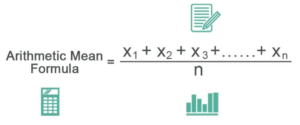Table of Contents
Arithmetic Mean For IIt JEE
The arithmetic mean of two numbers is defined as the sum of the numbers divided by the number of numbers. Similarly, in a collection, the arithmetic mean is defined as the sum of the numbers in the collection divided by the number of numbers in the collection. Arithmetic progression is another term that is closely related to the arithmetic mean.
Arithmetic mean is abbreviated as A.M., whereas arithmetic progression is abbreviated as A.P. If there are three terms in A.P., the middle term is known as the arithmetic mean (A.M.) between the other two. We can state mathematically that If a, b, and c are in A.P., then b = (a+c)/2 is a and c’s A.M.
The arithmetic mean is the mean or average of a set of data or a collection of data. The arithmetic mean is calculated by adding the given set of numbers and dividing the total by the number of numbers in the set. In surveys and experimental studies, the arithmetic mean is used. It is classified as statistics in the field of mathematics. There are several types of means in mathematics, including arithmetic mean, arithmetic harmonic mean, geometric mean, and geometric harmonic mean. The term arithmetic mean is simply used to distinguish it from the other means.

Arithmetic Mean Formula
The general formula for calculating the arithmetic mean of a set of data is:
Mean (x) = Sum of all observations divided by the number of observations
It is represented by the symbol x. (read as x bar). Data can be presented in a variety of ways. For example, if we have raw data such as a student’s marks in five subjects, we add the marks from the five subjects and divide the total by 5, because there are five subjects in total.

Properties of Arithmetic Mean
The following are some important properties of the arithmetic mean:
- The sum of the deviations from the arithmetic mean of the items is always zero, i.e.∑(x – X) = 0.
- The sum of the items’ squared deviations from Arithmetic Mean (A.M) is minimum, which is less than the sum of the items’ squared deviations from any other values.
- If the mean is used to replace each item in the arithmetic series, the sum of these replacements equals the sum of the specific items.
FAQs
What exactly is arithmetic mean?
The arithmetic mean, also known as the mean, is the simplest way to compute the average for a given set of numbers. It is divided into two types: simple arithmetic mean, and weighted arithmetic mean.
How do you compute the arithmetic mean?
The arithmetic mean is defined as the ratio of the total number of observations to the sum of all given observations. For example, if the data set contains five observations, the arithmetic mean can be calculated by adding all five observations and dividing them by five.
What is the difference between arithmetic mean and a mean?
The average, also known as the arithmetic mean, is defined as the sum of all values divided by the number of values. Mean, on the other hand, is the data's average. In statistics, the mean is calculated by dividing the total number of observations by the number of observations.






